2014 SUBARU TRIBECA warning
[x] Cancel search: warningPage 61 of 426
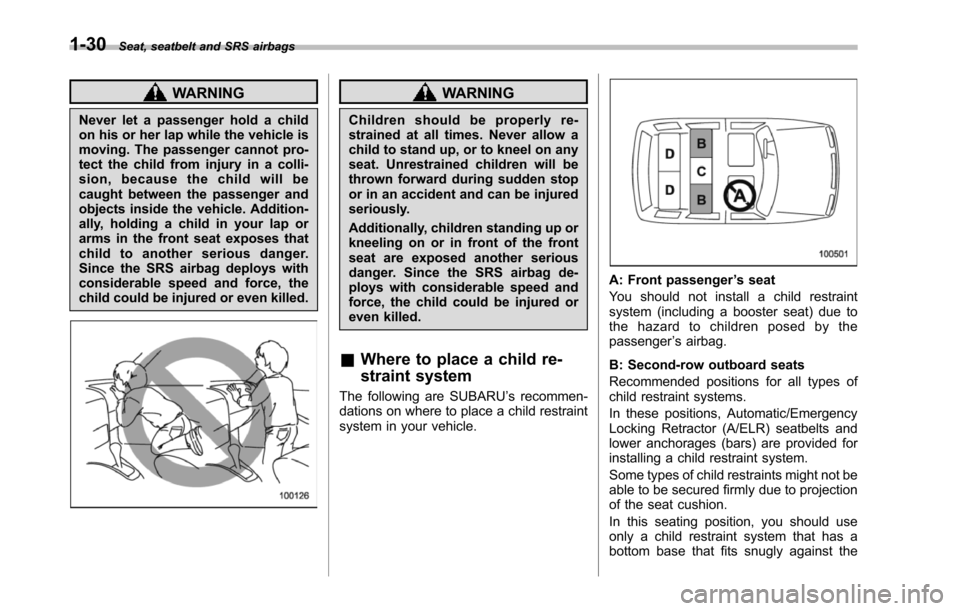
1-30Seat, seatbelt and SRS airbags
WARNING
Never let a passenger hold a childon his or her lap while the vehicle ismoving. The passenger cannot pro-tect the child from injury in a colli-sion, because the child will becaught between the passenger andobjects inside the vehicle. Addition-ally, holding a child in your lap orarms in the front seat exposes thatchild to another serious danger.Since the SRSairbag deploys withconsiderable speed and force, thechild could be injured or even killed.
WARNING
Children should be properly re-strained at all times. Never allow achild to stand up, or to kneel on anyseat. Unrestrained children will bethrown forward during sudden stopor in an accident and can be injuredseriously.
Additionally, children standing up orkneeling on or in front of the frontseat are exposed another seriousdanger. Since the SRS airbag de-ployswith considerable speed andforce, the child could be injured oreven killed.
&Where to place a child re-
straint system
The following are SUBARU’s recommen-dations on where to place a child restraintsystem in your vehicle.
A: Front passenger’s seat
You should not install a child restraintsystem (including a booster seat) due tothe hazard to children posed by thepassenger’s airbag.
B: Second-row outboard seats
Recommended positions for all types ofchild restraint systems.
In these positions, Automatic/EmergencyLocking Retractor (A/ELR) seatbelts andlower anchorages (bars) are provided forinstalling a child restraint system.
Some types of child restraints might not beable to be secured firmly due to projectionof the seat cushion.
In this seating position, you should useonly a child restraint system that has abottom base that fits snugly against the
Page 62 of 426
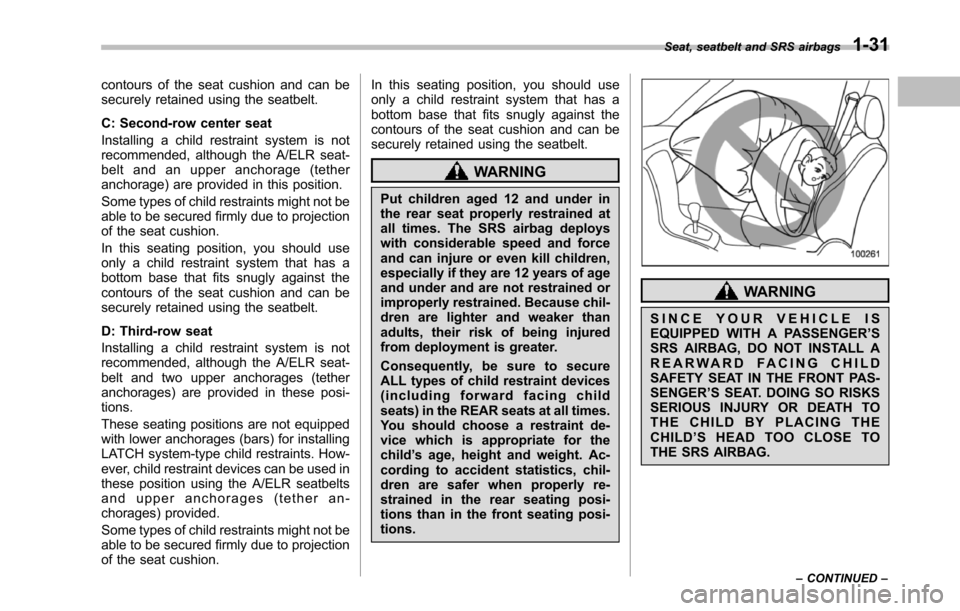
contours of the seat cushion and can besecurely retained using the seatbelt.
C: Second-row center seat
Installing a child restraint system is notrecommended, although the A/ELR seat-belt and an upper anchorage (tetheranchorage) are provided in this position.
Some types of child restraints might not beable to be secured firmly due to projectionof the seat cushion.
In this seating position, you should useonly a child restraint system that has abottom base that fits snugly against thecontours of the seat cushion and can besecurelyretained using the seatbelt.
D: Third-row seat
Installing a child restraint system is notrecommended, although the A/ELR seat-belt and two upper anchorages (tetheranchorages)are provided in these posi-tions.
These seating positions are not equippedwith lower anchorages (bars) for installingLATCH system-type child restraints. How-ever, child restraint devices can be used inthese position using the A/ELR seatbeltsand upper anchorages (tether an-chorages) provided.
Some typesof child restraints might not beable to be secured firmly due to projectionof the seat cushion.
In this seating position, you should useonly a child restraint system that has abottom base that fits snugly against thecontours of the seat cushion and can besecurely retained using the seatbelt.
WARNING
Put children aged 12 and under inthe rear seat properly restrained atalltimes. The SRS airbag deployswith considerable speed and forceand can injure or even kill children,especially if they are 12 years of ageand under and are not restrained orimproperly restrained. Because chil-dren are lighter and weaker thanadults, their risk of being injuredfrom deployment is greater.
Consequently, be sure to secureALL types of child restraint devices(including forward facing childseats) in the REAR seats at all times.You should choose a restraint de-vice which is appropriate for thechild’s age, height and weight. Ac-cording to accident statistics, chil-dren are safer when properly re-strained in the rear seating posi-tions than in the front seating posi-tions.
WARNING
SINCE YOUR VEHICLE ISEQUIPPED WITH A PASSENGER’SSRS AIRBAG, DO NOT INSTALL AREARWARD FACING CHILDSAFETY SEAT IN THE FRONT PAS-SENGER’S SEAT. DOING SO RISKSSERIOUS INJURY OR DEATH TOTHE CHILD BY PLACING THECHILD’SHEADTOOCLOSETOTHE SRS AIRBAG.
Seat, seatbelt and SRS airbags1-31
–CONTINUED–
Page 63 of 426
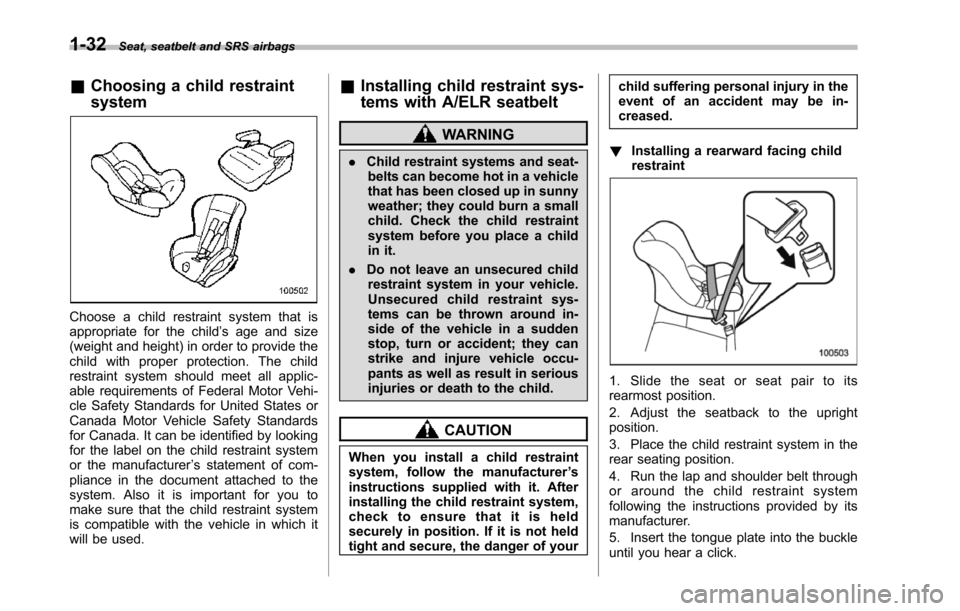
1-32Seat, seatbelt and SRS airbags
&Choosing a child restraint
system
Choose a child restraint system that isappropriate for the child’s age and size(weight and height) in order to provide thechild with proper protection. The childrestraint system should meet all applic-able requirements of Federal Motor Vehi-cle Safety Standards for United States orCanada Motor Vehicle Safety Standardsfor Canada. It can be identified by lookingfor the label on the child restraint systemor the manufacturer’s statement of com-pliance in the document attached to thesystem. Also it is important for you tomake sure thatthe child restraint systemis compatible with the vehicle in which itwill be used.
&Installing child restraint sys-
tems with A/ELR seatbelt
WARNING
.Child restraint systems and seat-belts can become hot in a vehiclethat has been closed up in sunnyweather; they could burn a smallchild. Check the child restraintsystem before you place a childin it.
.Do not leave an unsecured childrestraint system in your vehicle.Unsecured child restraint sys-tems can be thrown around in-side of the vehicle in a suddenstop, turn or accident; they canstrikeand injure vehicle occu-pants as well as result in seriousinjuries or death to the child.
CAUTION
When you install a child restraintsystem, follow the manufacturer’sinstructions supplied with it. Afterinstalling the child restraint system,check to ensure that it is heldsecurely in position. If it is not heldtight and secure, the danger of your
child suffering personal injury in theevent of an accident may be in-creased.
!Installing a rearward facing childrestraint
1. Slide the seat or seat pair to itsrearmost position.
2. Adjust the seatback to the uprightposition.
3. Place the child restraint system in therear seating position.
4. Run the lap and shoulder belt throughor around the child restraint systemfollowing the instructions provided by itsmanufacturer.
5. Insert the tongue plate into the buckleuntil you hear a click.
Page 64 of 426

6. Take up the slack in the lap belt.
7. Pull out the seatbelt fully from theretractor to change the retractor over fromthe Emergency Locking Retractor (ELR)to the Automatic Locking Retractor (ALR)mode. Then, allow the belt to rewind intothe retractor. As the belt is rewinding,clicks will be heard which indicate theretractor functions as ALR.
8. Push and pull the child restraintsystem forward and from side to side tocheck if it is firmly secured.
Sometimes a child restraint can be morefirmlysecured by pushing it down into theseat cushion and then tightening theseatbelt.
9. Pull at the shoulder portion of the beltto confirm that it cannot be pulled out (ALRproperly functioning).
10. To remove the child restraint system,press the release button on the seatbeltbuckle and allow the belt to retractcompletely. The belt will return to theELR mode.
WARNING
NEVER INSTALL A REARWARD FA-CING CHILD SEAT IN THE FRONTPA S S E N G E R’SSEAT.DOINGSORISKS SERIOUS INJURY OR DEATHTO THE CHILD BY PLACING THECHILD’S HEAD TOO CLOSE TO THESRS AIRBAG.
Seat, seatbelt and SRS airbags1-33
–CONTINUED–
Page 67 of 426
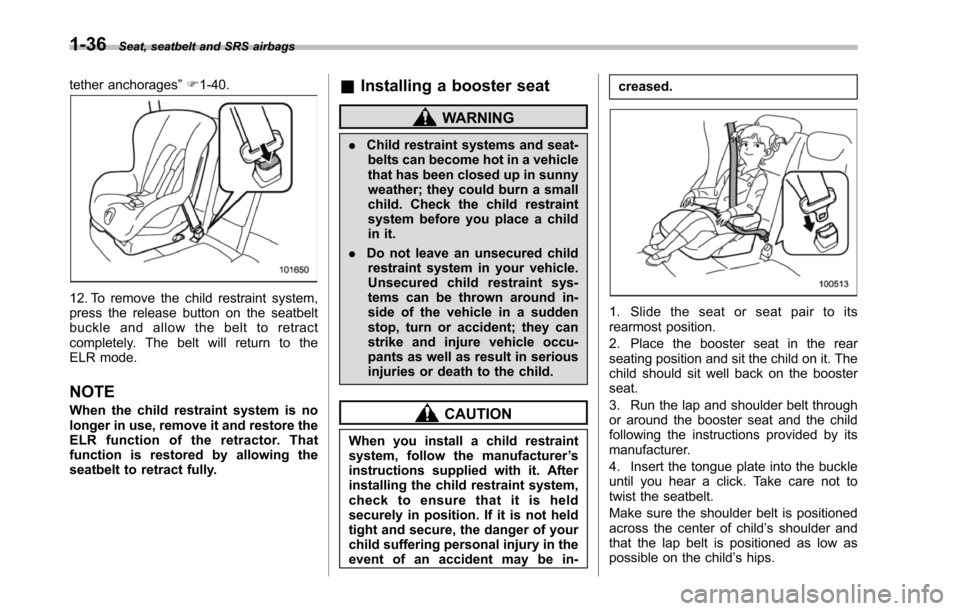
1-36Seat, seatbelt and SRS airbags
tether anchorages”F1-40.
12. To remove the child restraint system,press the release button on the seatbeltbuckle and allow the belt to retractcompletely. The belt will return to theELR mode.
NOTE
When the child restraint system is nolonger in use, remove it and restore theELR function of the retractor. Thatfunction is restored by allowing theseatbelt to retract fully.
&Installing a booster seat
WARNING
.Child restraint systems and seat-belts can become hot in a vehiclethat has been closed up in sunnyweather; they could burn a smallchild. Check the child restraintsystem before you place a childin it.
.Do not leave an unsecured childrestraint system in your vehicle.Unsecured child restraint sys-tems can be thrown around in-side of the vehicle in a suddenstop, turn or accident; they canstrike and injure vehicle occu-pants as well as result in seriousinjuriesor death to the child.
CAUTION
When you install a child restraintsystem, follow the manufacturer’sinstructions supplied with it. Afterinstalling the child restraint system,check to ensure that it is heldsecurely in position. If it is not heldtight and secure, the danger of yourchild suffering personal injury in theevent of an accident may be in-
creased.
1. Slide the seat or seat pair to itsrearmost position.
2. Place the booster seat in the rearseating position and sit the child on it. Thechild should sit well back on the boosterseat.
3. Run the lap and shoulder belt throughor around the booster seat and the childfollowing the instructions provided by itsmanufacturer.
4. Insert the tongue plate into the buckleuntil you hear a click. Take care not totwist the seatbelt.
Make sure the shoulder belt is positionedacross the center of child’s shoulder andthat the lap belt is positioned as low aspossible on the child’s hips.
Page 68 of 426
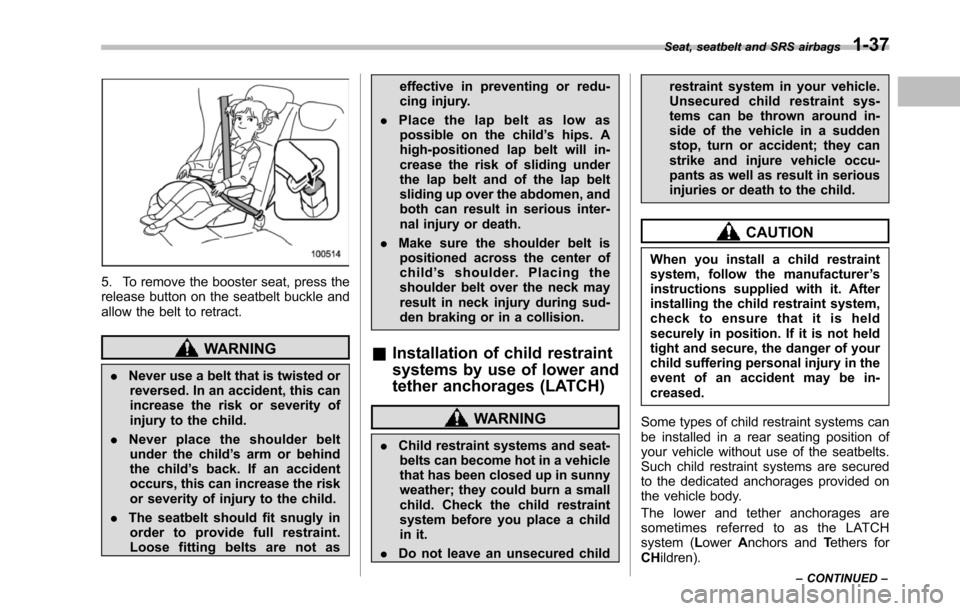
5. To remove the booster seat, press therelease button on the seatbelt buckle andallow the belt to retract.
WARNING
.Never use a belt that is twisted orreversed.In an accident, this canincrease the risk or severity ofinjury to the child.
.Never place the shoulder beltunder the child’s arm or behindthe child’s back. If an accidentoccurs, this can increase the riskor severity of injury to the child.
.The seatbelt should fit snugly inorder to provide full restraint.Loose fitting belts are not as
effective in preventing or redu-cing injury.
.Place the lap belt as low aspossible on the child’s hips. Ahigh-positioned lap belt will in-crease the risk of sliding underthe lap belt and of the lap beltsliding up over the abdomen, andboth can result in serious inter-nalinjury or death.
.Make sure the shoulder belt ispositioned across the center ofchild’sshoulder.Placingtheshoulder belt over the neck mayresult in neck injury during sud-den braking or in a collision.
&Installation of child restraint
systems by use of lower and
tether anchorages (LATCH)
WARNING
.Child restraint systems and seat-belts can become hot in a vehiclethat has been closed up in sunnyweather; they could burn a smallchild.Check the child restraintsystem before you place a childin it.
.Do not leave an unsecured child
restraint system in your vehicle.Unsecured child restraint sys-tems can be thrown around in-side of the vehicle in a suddenstop, turn or accident; they canstrike and injure vehicle occu-pants as well as result in seriousinjuries or death to the child.
CAUTION
When you install a child restraintsystem, follow the manufacturer’sinstructions supplied with it. Afterinstalling thechild restraint system,check to ensure that it is heldsecurely in position. If it is not heldtight and secure, the danger of yourchild suffering personal injury in theevent of an accident may be in-creased.
Some types of child restraint systems canbe installed in a rear seating position ofyour vehicle without use of the seatbelts.Such child restraint systems are securedto the dedicated anchorages provided onthe vehicle body.
The lower and tether anchorages aresometimes referred to as the LATCHsystem (LowerAnchors andTethers forCHildren).
Seat, seatbelt and SRS airbags1-37
–CONTINUED–
Page 76 of 426
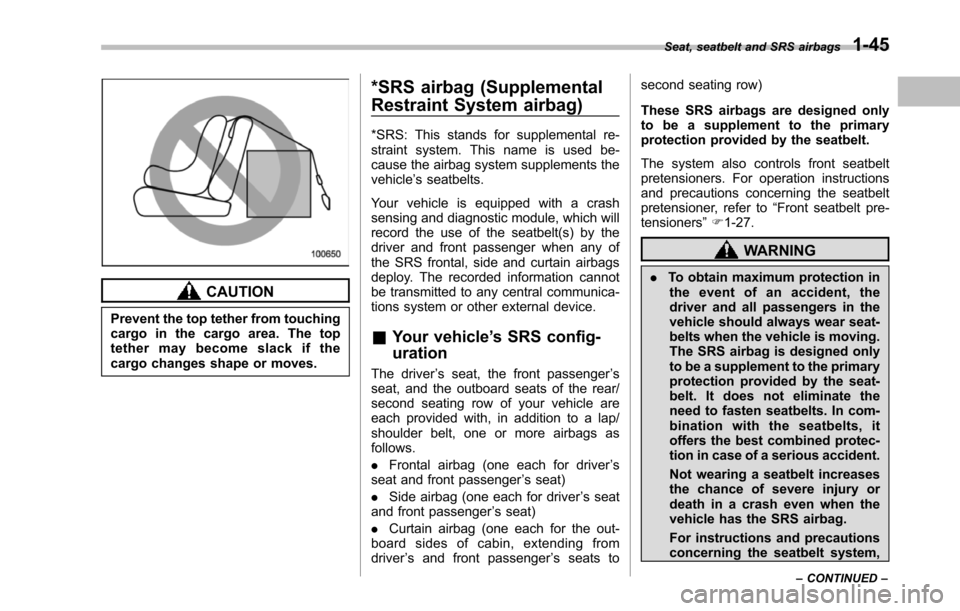
CAUTION
Prevent the top tether from touchingcargo in the cargo area. The toptether may become slack if thecargo changes shape or moves.
*SRS airbag (Supplemental
Restraint System airbag)
*SRS: This stands for supplemental re-straint system. This name is used be-cause the airbag system supplements thevehicle’s seatbelts.
Your vehicle is equipped with a crashsensing and diagnostic module, which willrecord the use of the seatbelt(s) by thedriver and front passenger when any oftheSRS frontal, side and curtain airbagsdeploy. The recorded information cannotbe transmitted to any central communica-tions system or other external device.
&Your vehicle’s SRS config-
uration
The driver’s seat, the front passenger’sseat, and the outboard seats of the rear/second seating row of your vehicle areeach provided with, in addition to a lap/shoulder belt, one or more airbags asfollows.
.Frontal airbag (one each for driver’sseat and front passenger’s seat)
.Side airbag (one each for driver’s seatand front passenger’s seat)
.Curtain airbag (one each for the out-board sides of cabin, extending fromdriver’s and front passenger’s seats to
second seating row)
These SRS airbags are designed onlyto be a supplement to the primaryprotection provided by the seatbelt.
The system also controls front seatbeltpretensioners. For operation instructionsand precautions concerning the seatbeltpretensioner, refer to“Frontseatbelt pre-tensioners”F1-27.
WARNING
.To obtain maximum protection inthe event of an accident, thedriverand all passengers in thevehicle should always wear seat-belts when the vehicle is moving.The SRS airbag is designed onlyto be a supplement to the primaryprotection provided by the seat-belt. It does not eliminate theneed to fasten seatbelts. In com-bination with the seatbelts, itoffers the best combined protec-tion in case of a serious accident.
Not wearing a seatbelt increasesthe chance of severe injury ordeath in a crash even when thevehicle has the SRS airbag.
For instructions and precautionsconcerning the seatbelt system,
Seat, seatbelt and SRS airbags1-45
–CONTINUED–
Page 77 of 426
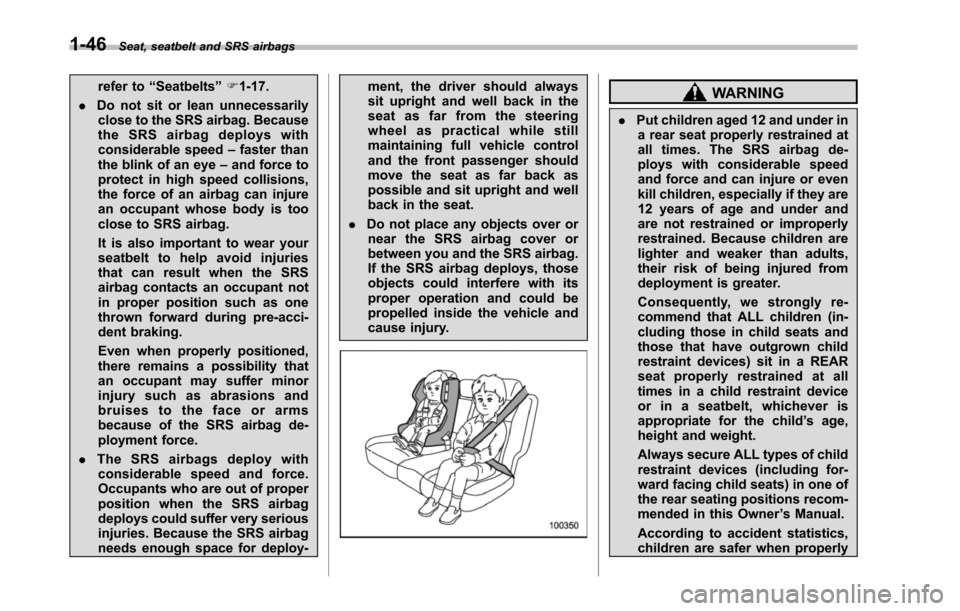
1-46Seat, seatbelt and SRS airbags
refer to“Seatbelts”F1-17.
.Do not sit or lean unnecessarilyclose to the SRS airbag. Becausethe SRS airbag deploys withconsiderable speed–faster thanthe blink of an eye–and force toprotect in high speed collisions,the force of an airbag can injurean occupant whose body is tooclose to SRS airbag.
It is also important to wear yourseatbelt to help avoid injuriesthat can result when the SRSairbag contacts an occupant notin proper position such as onethrown forward during pre-acci-dent braking.
Even when properly positioned,there remainsa possibility thatan occupant may suffer minorinjury such as abrasions andbruises to the face or armsbecause of the SRS airbag de-ployment force.
.The SRS airbags deploy withconsiderable speed and force.Occupants who are out of properposition when the SRS airbagdeploys could suffer very seriousinjuries. Because the SRS airbagneeds enough space for deploy-
ment, the driver should alwayssit upright and well back in theseat as far from the steeringwheel as practical while stillmaintaining full vehicle controland the front passenger shouldmove the seat as far back aspossible and sit upright and wellback in the seat.
.Do not place any objects over ornear the SRS airbag cover orbetween you and the SRS airbag.If the SRS airbag deploys, thoseobjects could interfere with itsproper operation and could bepropelled inside the vehicle andcause injury.
WARNING
.Put children aged 12 and under ina rear seat properly restrained atall times. The SRS airbag de-ploys with considerable speedand force and can injure or evenkill children, especially if they are12 years of age and under andare not restrained or improperlyrestrained. Because children arelighter and weaker than adults,their risk of being injured fromdeployment is greater.
Consequently, we strongly re-commend that ALL children (in-cluding those in child seats andthose that have outgrown childrestraintdevices) sit in a REARseat properly restrained at alltimes in a child restraint deviceor in a seatbelt, whichever isappropriate for the child’s age,height and weight.
Always secure ALL types of childrestraint devices (including for-ward facing child seats) in one ofthe rear seating positions recom-mended in this Owner’s Manual.
According to accident statistics,children are safer when properly